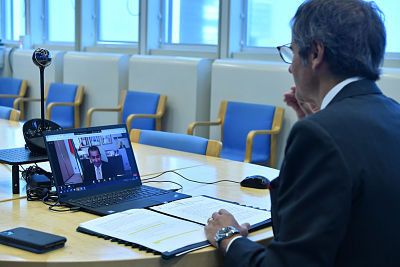How to Navigate Cultural Differences and Become a Successful Virtual Team Leader
The recent surge of staff working from home has turned many leaders into ‘virtual’ leaders overnight.
In an environment where global collaboration tools are increasingly accessible, leaders are less likely to report technology as the biggest challenge.
Instead, the most common challenge tends to be maintaining a sense of team and motivating disparate team members to come together and deliver on the shared team vision.
There are a number of approaches adopted by successful team leaders which make a significant difference in shaping a productive and engaged virtual team.
Below, we’ve included a selection of the most straightforward and easy to implement.
Check out the FREE sample of our
eLearning COURSE on working across cultures
It's at the end of the page
5 Ways to Become an Effective Virtual Team Leader
1. Facilitate engagement
The most important aim of leadership is to motivate team members to deliver visionary goals.
This can be facilitated by removing obstacles, promoting inter-team communication and ensuring that systems and processes make it as easy as possible for team members to do what they need to do.
Clarity is best promoted by ensuring team members both understand each other’s roles and know who to reach out to for support or collaboration.
Where possible, you should encourage team members with oversight for particular areas to touch base with their colleagues on a regular basis to ensure there are no questions or challenges.
By encouraging a supportive environment in which colleagues actively engage with each other, the delivery of vision becomes far easier.
2. Understand the cultures of your team members
If you’re leading a global multicultural team, then it’s critical that you take the time to understand the cultural frameworks of the individual team members, as these will influence the way in which individuals work within a virtual setting and their expectations of you and their colleagues.
If virtual leaders don’t recognise the influence of cultural differences on their team, then these differences are liable to trip them up at some point.
Let’s give you an example of how.
In some cultures, people may be less inclined to say what they really feel. They may well smile and claim that everything is fine, when in fact it isn’t. This can lead to issues going unrecognised and unresolved, possible de-motivating team members or causing team conflict.
As another example, in some cultures, people are very happy to give ‘constructive’ feedback. If they deliver feedback of this nature in an open webinar to a colleague where the cultural concept of ‘face’ is important then they may well destroy team trust.
Understanding cultural nuances is important if you’re to encourage productive and open conversations.
Cultural awareness training will give you the understanding needed to adapt your approach to get the best out of a situation.
3. Build team relationships
Motivating your team members to achieve team-wide goals is far easier if they are functioning well as a team.
In the physical environment, ‘water cooler’ moments enable team members to engage in a more informal way and to focus on nonwork-related topics which, in turn, promotes relationship building and team bonding.
Since this isn’t an option in a virtual team then it’s advisable for virtual leaders to consider a virtual equivalent.
Depending on the makeup and time zones of your team, you might want to arrange a monthly get together, whereby people log onto a group webinar to discuss non work-related topics.
Maybe ask team members to bring a drink or snack to add to the sense of socialising. For teams that aren’t naturally talkative, consider a ‘theme’ to kick the session off.
These sessions will go a long way to boosting the sense of team and building positive relationships.

Managing people from around the world requires a certain level of cultural awareness.
Click here to visit our guides to management cultures around the globe
Photo by LinkedIn Sales Solutions on Unsplash
4. Be Approachable
In physical teams, it’s far easier to sense when there is conflict at play, or when team members are unhappy or struggling. In virtual teams, this can be very difficult.
To lead your team well, it’s essential that you become a master of approachability!
Make the effort to engage regularly with your team members and use your active listening skills to demonstrate that you are really invested in how they are doing.
Don’t just listen with your ears – listen with your eyes too. Observe how people respond to what you say and look out for what they don’t say as well as what they do say.
Culture also plays an important role in the way in which team members communicate challenges or problems.
Understanding these cultural differences will go a long way to helping you manage your conversations productively.
Contact your team members regularly to discuss their work and commitments.
Make a point of offering positive feedback when it’s due and make sure they feel comfortable discussing challenges with you.
If something needs to be resolved, then direct them to the best person to help. Make sure you follow up shortly after to ensure the situation has been resolved.
5. Make sure your team are pulling in the same direction
Although your team are virtually dispersed, they should still be pulling in the same direction and working towards the delivery of the same goals.
As such, it’s essential that your team members are clear about these goals and their role in meeting them.
On a regular basis, ask your team members to summarise team goals and to give an overview of their role in meeting these goals.
This will remind team members of why they are doing what they are doing and reinforce the collective role of team members in delivering the vision.
Training on Virtual Leadership

Becoming a successful virtual team leader takes time.
In fact it’s fair to say that it’s a journey.
Regularly reflecting on your progress and applying approaches such as those outlined above, will go a long way to helping you lead a productive team.
If, however, you’d like to accelerate your progress with virtual leadership training, then contact us.
Take a Course on Cultural Differences at Work
If you would like to develop an understanding of the influence of culture on your international team, then sign-up to our eLearning Cultural Awareness online course.
Jam-packed with practical strategies, know-how and insights, this course is a perfect way to help you navigate cultural differences with confidence.
You can watch a sample of the video below or go over the course page to learn more.
Related Posts
By accepting you will be accessing a service provided by a third-party external to https://www.commisceo-global.com/

 +44 0330 027 0207 or +1 (818) 532-6908
+44 0330 027 0207 or +1 (818) 532-6908
